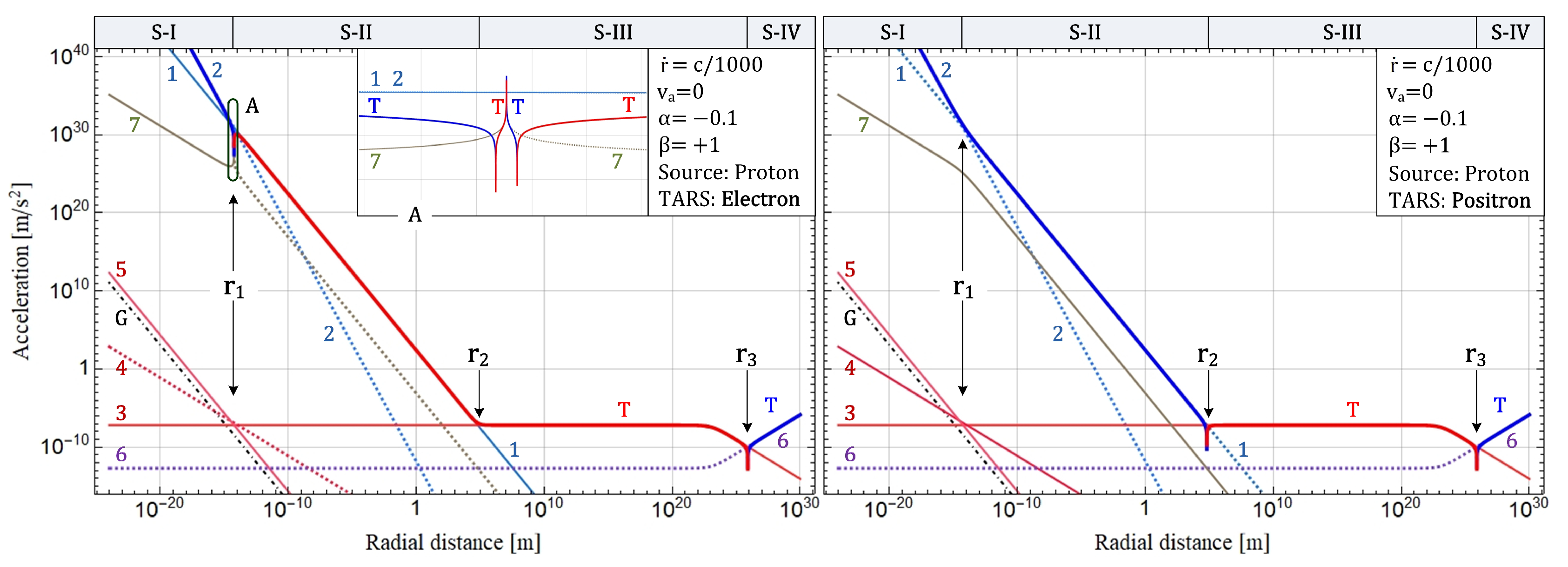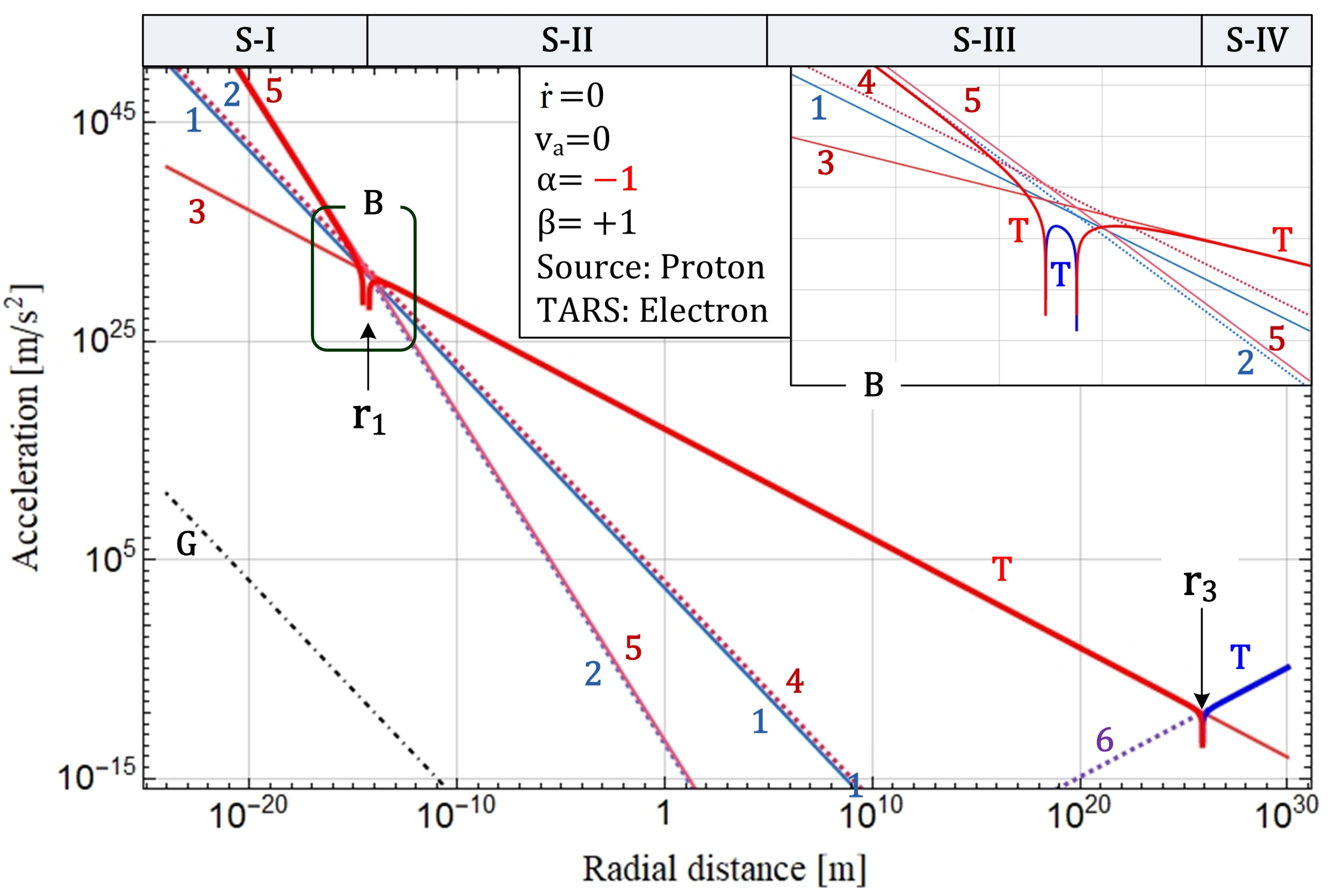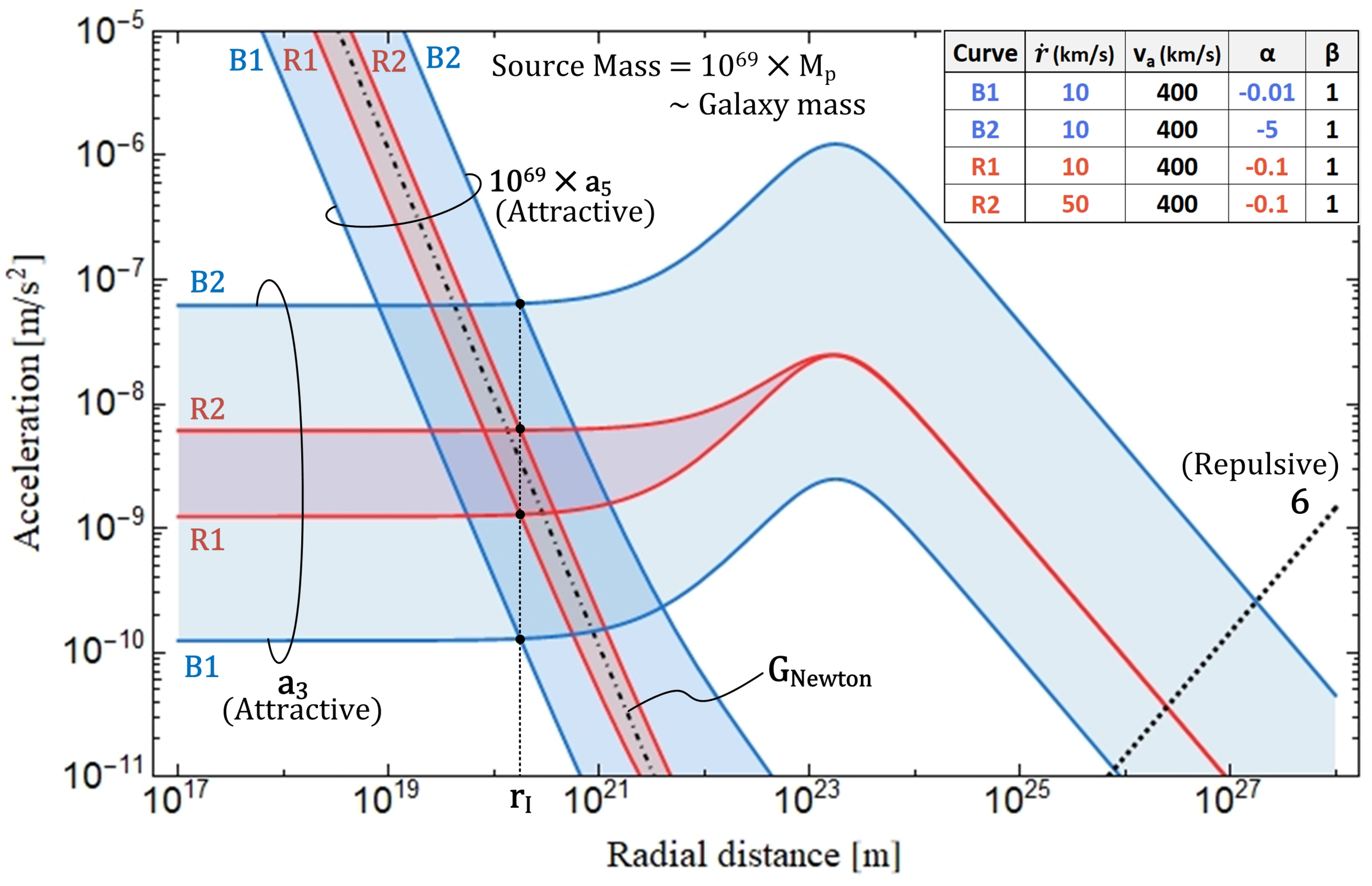Submitted:
31 March 2023
Posted:
31 March 2023
You are already at the latest version
Abstract
Keywords:
1. Introduction
2. Theory
2.1. Postulate 1 - Mach Principle
2.2. Postulate 2 - Constant of Motion
2.3. Postulate 3 - Metric Tensor
2.4. Equation of Motion
3. Application and Discussion
3.1. System of : Inflationary and Accelerating Expansions of the Universe
3.2. System of : Determining
3.3. Physical Meanings of the Constant of Motion
3.4. Distribution Factors of Proton and Electron
3.5. Implications of Equation (22)
3.6. Quantum Phenomena : Implications of Equation (7)
3.7. Missing Mass Problem: Lensing Mass Distribution
3.8. System of : Eight Separate Forces
3.9. Interesting and Perplexing Aspects of Eqs. (25) and (26)
- [A1]
- Based on three intersection points at , , and , the whole space can be divided into four distinct shells S-I to S-IV, which are governed by different terms , and , respectively.
- [A2]
- The total acceleration in the shell S-IV is positive, as discussed in Sec. 3.1. Meanwhile, using the mathematica codes, one can find that, in order to obtain such a positive acceleration and the distance of 8.1 billion ly (calculated in Sec. 3.1) as the value of , the parameter should be a value close to +1, as assumed for the plotting. Thus, hereinafter, we will refer to the value of as . In addition, since, except for the value of , most of the results discussed in this article are less sensitive to the value of , we will suppose that this choice is valid. This means that we will use the Hubble’s law as it is.
- [A3]
- The total acceleration in the shell S-III has an almost constant negative value. According to Newtonian physics, this gives the result of , which may allow us to explain the galaxy rotation anomaly[18], without invoking the dark matter hypothesis[19]. Meanwhile, the above-stated boosting effect will make the gradient of the distribution factor steeper, and thus, this effect may also be partly responsible for the galaxy rotation anomaly.
- [A4]
- At , a ratio between strengths of the curves 2, 1, 7, and 5 is about that is similar to that between the known four fundamental forces. Based on this clue, hereinafter, we will examine whether , and can be interpreted as the strong, electric, weak, and gravitational terms.
- [A5]
- In particular, the term obeys the law of inverse square and has a direction independent of the sign of electric charge, because it is written in the form of . Especially, it should be noted that, despite the fact that the Newton constant is not used to plot the curve 5, the curve 5 is plotted along and very close to a reference line G showing the gravitational field of the proton, as shown in Figure 1. In this sense, we can strongly suspect that the term is responsible for the gravitational force.
- [B1]
- In the shell S-III, the term is excessively high, compared with the reasonable value (e.g., of about in the MOND theory[20]). Similarly, there is a slight discrepancy in strength between the curves 5 and G.
- [B2]
- The point is slightly different from the known proton radius .
- [B3]
- There is an issue in direction of each of the terms , , and . In detail, the term is always repulsive, and thus, it is clear that the strong force cannot be explained by the term alone. Also, the terms and are attractive or repulsive, depending on a sign of , although they are independent of the sign of electric charge. This means that there are difficulties in explaining the galaxy rotation anomaly and the gravitational force through the terms and .
- [B4]
- At the moment, it is unclear that the term is responsible for the weak force.
3.10. Some Possibilities for Perplexing Aspects
4. Proposal of Experimental Tests
5. Conclusions
Acknowledgments
Appendix A. Comments on Postulate 2
- •
- Summary of GR and OA
- •
- Similarities and differences between GR and OA
- (C1)
- (C2)
- A metric tensor is used to project the starting equation onto a reference frame of the laboratory observer (i.e., Murphy).
- (D1)
- (D2)
- There is a difference in physical state between chosen observers, for whom the starting equations are valid.
- (D3)
- There is a difference in physical meanings of the metric tensor. This topic will be explained in Appendix B.
- •
- Difference in physical state between observers and its implications
- •
- Constant of motion
Appendix B. Comments on Postulate 3
- •
- Ratios between spatial lengths: Eq. (4) in the main text
- •
- Ratios between temporal lengths: Eq. (5) in the main text
- •
- At least one postulate is needed
- •
- Metric tensor for spherically symmetric system
- 1)
- show and ,
- 2)
- find a method of incorporating the time-dependent distribution factor into the metric, and
- 3)
- show that, in a spherical coordinate system, only time and radial components depend on the distribution factor.
Appendix C. Derivation of Eq. (9)
Appendix D. Derivation of Eqs. (10)-(12)
Appendix E. Mathematica code for Figure 1 and Figure 2
Appendix F. Mathematica code for Figure 3
References
- Guth AH. 1981 Inflationary universe: A possible solution to the horizon and flatness problems. Physical Review D. 23(2), 347-356. [CrossRef]
- Riess AG, et al. 1998 Observational evidence from supernovae for an accelerating universe and a cosmological constant. Astron. J. 116(3), 1009-38. [CrossRef]
- Perlmutter S, et al. 1999 Measurements of Omega and Lambda from 42 high redshift supernovae. Astrophys. J. 517 (2), 565-86. [CrossRef]
- Zwicky F. 1933 Die Rotverschiebung von extragalaktischen Nebeln (Title in English: The red shift of extragalactic nebulae). Helv. Phys. Acta. 6, 110–127. [CrossRef]
- Rubin V, Ford WK., Jr. 1970 Rotation of the Andromeda Nebula from a Spectroscopic Survey of Emission Regions. Astrophys. J. 159, 379-403. [CrossRef]
- Clowe D. et al. 2006 A Direct Empirical Proof of the Existence of Dark Matter. Astrophys. J. 648, L109–L113. [CrossRef]
- van Dokkum P. et al. 2016 A high stellar velocity dispersion and ~100 globular clusters for the ultra-diffuse galaxy Dragonfly 44. Astrophys. J. 828, L6. [CrossRef]
- van Dokkum P. et al. 2018 A galaxy lacking dark matter. Nature 555, 629–632. [CrossRef]
- de Broglie L. 1923 Waves and Quanta. Nature 112, 540. [CrossRef]
- Davisson CJ, Germer LH. 1927 The scattering of electrons by a single crystal of nickel. Nature 119, 558–560. [CrossRef]
- Weinberg S. 1972 GRAVITATION AND COSMOLOGY: PRINCIPLES AND APPLICATIONS OF THE GENERAL THEORY OF RELATIVITY. New York: John Wiley & Sons. 70-72.
- Riess AG, Casertano S, Yuan W, Macri LM, Scolnic D. 2019 Large Magellanic Cloud Cepheid Standards Provide a 1% Foundation for the Determination of the Hubble Constant and Stronger Evidence for Physics Beyond ΛCDM. Preprint at https://arxiv.org/abs/1903.07603. [CrossRef]
- Frieman JA, Turner MS, Huterer D. 2008 Dark Energy and the Accelerating Universe. Ann.Rev.Astron.Astrophys. 46, 385-432.(. [CrossRef]
- Schwarzschild K. 1916 On the gravitational field of a mass point according to Einstein’s theory. Sitzungsber. Preuss. Akad. Wiss. Berlin (Math. Phys.) 1916. Bibcode:1916AbhKP......189S. (https://arxiv.org/abs/physics/9905030).
- Weinberg, S. 1972 GRAVITATION AND COSMOLOGY: PRINCIPLES AND APPLICATIONS OF THE GENERAL THEORY OF RELATIVITY. New York: John Wiley & Sons. 185.
- Bach R, Pope D, Liou SH, Batelaan H. 2013 Controlled double-slit electron diffraction. New J. Phys. 15, 033018. [CrossRef]
- Hubble E. 1929 A relation between distance and radial velocity among extra-galactic nebulae. Proc. Natl. Acad. Sci. USA. 15, 168-73. [CrossRef]
- Corbelli E, Salucci P. 2000 The extended rotation curve and the dark matter halo of M33. MNRAS 311, 441. [CrossRef]
- de Swart JG, Bertone G, van Dongen J. 2017 How dark matter came to matter. Nature Astronomy 1, 0059. [CrossRef]
- Milgrom M. 1983 A modification of the Newtonian dynamics: Implications for galaxy systems. Astrophys. J. 270, 384–389. [CrossRef]
- Schrödinger E. 1926 An Undulatory Theory of the Mechanics of Atoms and Molecules. Physical Review 28, 1049–1070. Bibcode:1926PhRv...28.1049S. [CrossRef]
- Matsumoto N et al. 2019 Demonstration of Displacement Sensing of a mg-Scale Pendulum for mm- and mg-Scale Gravity Measurements. Phys. Rev. Lett. 122, 071101. [CrossRef]
- Sakharov AD. 1967 Vacuum quantum fluctuations in curved space and the theory of gravitation. Dokl. Akad. Nauk SSSR, 177, 70–71. [CrossRef]
- Verlinde E. 2011 On the origin of gravity and the laws of Newton. JHEP. 2011, 29. [CrossRef]
- Roberts JL et al. 2001 Controlled Collapse of a Bose-Einstein Condensate. Phys. Rev. Lett. 86, 4211. [CrossRef]
| 1 | This quantity is related to a total energy of a system, as will be shown below. In this sense, it seems necessary to further examine the negative solution in the context of Dirac’s work on the antimatter. |
| 2 | Although not discussed further here, the broken vacuum symmetry and the matter-antimatter asymmetry may be closely related to the facts that has a non-vanishing positive value (i.e., 1) asymmetrically deviated from a notional vacuum value (i.e., 0) and that the two functions , which are asymmetrical about and are assigned to proton and electron, are likely to be the most stable forms. |
| 3 | Indeed, the term also has the same direction issue. |
| 4 | Meanwhile, I think that both of two postulates in the special theory of relativity, including the postulate of , is closely related to the SPSQ principle, but the relationship therebetween is not the subject of this article. This is also our future work. |



Disclaimer/Publisher’s Note: The statements, opinions and data contained in all publications are solely those of the individual author(s) and contributor(s) and not of MDPI and/or the editor(s). MDPI and/or the editor(s) disclaim responsibility for any injury to people or property resulting from any ideas, methods, instructions or products referred to in the content. |
© 2023 by the authors. Licensee MDPI, Basel, Switzerland. This article is an open access article distributed under the terms and conditions of the Creative Commons Attribution (CC BY) license (http://creativecommons.org/licenses/by/4.0/).




